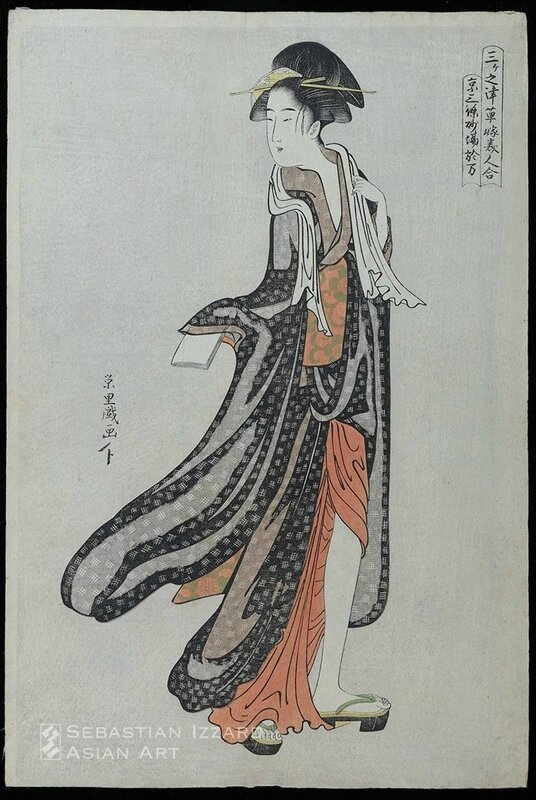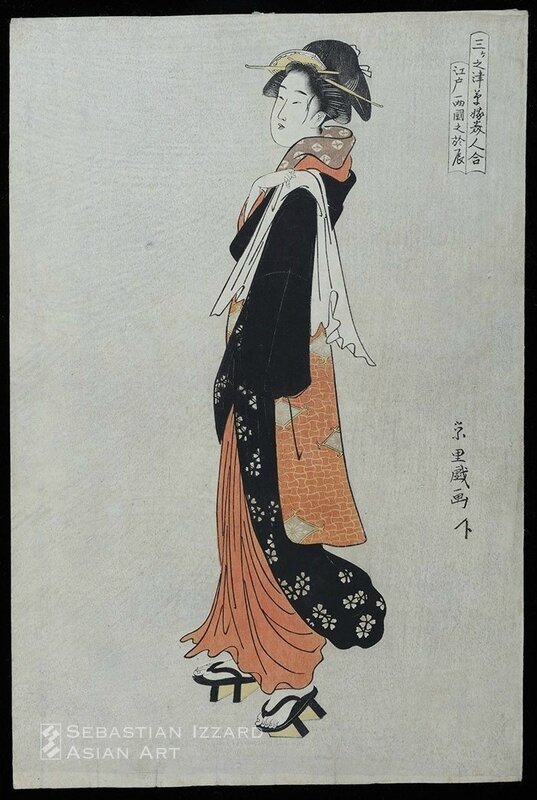Important Japanese prints from the collection of Henry Steiner on view in New York
NEW YORK, NY.- Sixty-two Japanese prints and one color woodblock album spanning nearly 150 years—from ca. 1710 to 1857—will go on view this March in an exhibition at Sebastian Izzard Asian Art in New York City. The works range from beauty prints by Kitagawa Utamaro, and actor prints by Tōshūsai Sharaku to Katsushika Hokusai’s iconic Great Wave. They were collected by Henry Steiner, the distinguished Hong Kong-based graphic designer, whose many corporate clients have included HSBC, for which he designed the iconic red and white hexagonal logo in 1983. The exhibition will be on view from March 17 to 29, 2018 during New York City’s Asia Week.
Henry Steiner (b. 1934, Vienna, Austria), emigrated in 1939 with his family to New York to avoid Nazi persecution. After receiving an MFA from Yale University, he worked for a year in New York City in advertising and design during the Mad Men era. He studied art independently in Paris for two years and, after returning briefly to New York, undertook freelance art design work for a Hong Kong publication. He soon moved to that city and in 1964 established Steiner & Co., a graphic design and brand consulting company.
Steiner began collecting in 1974, with works from the legendary collection of Henry Vever, and was most active in the 1970s and 1980s. He continued collecting until 2012. In an essay included in the exhibition catalogue, Brief History of an Addiction, Steiner writes that prints of 18th and 19th century Japan had “technical refinement unknown in the West” and that “ukiyo-e have a verve, a raucous humanity, combined with an unparalleled sensitivity of coloring.”
In the essay, Steiner writes, “I prudently kept my prints in a large box in a cold bank vault. Many friends questioned this strange practice.... I preferred keeping them safely away from fading and the Hong Kong humidity, with the occasional custodial visit.” Describing his visits to the vault as “rituals,” he recalled, “Unlocking the vault door and inhaling the slight, organic scent of the paper, opening the folders and fondly seeing the familiar images – feeling the imaginary equivalent of mild sunlight on my face – was always an example of what, to me, is the sense of cultural nobility such art confers upon their aficionados.”
Concluding his essay, Steiner writes, “A few months ago, I decided it was time to let my visual darlings travel to new homes and to have this catalogue as a souvenir. I entrust them (in the words of my collector predecessor Edmond de Goncourt) to the inheritors of my taste.”
Suzuki Harunobu (1724−1770), Woman Admiring Plum Blossom at Night. Color woodblock print: chūban tate-e, 13⅜ x 8⅜ in. (34 x 21.3 cm); 1766. Unsigned. © 2018 Sebastian Izzard LLC.
Subjects
Among Steiner’s interests were prints of “billboard girls” – women who became part of the brand of shops in Japan and were to Edo period Japan what Twiggy was to the 1960s or the Kardashians in our time. Ohisa was the eldest daughter of Takashima Chōbei, an official purveyor of Japanese rice crackers (sembei) to the shogunate. In Ohisa of the Takashimaya, by Utagawa Toyokuni, she is portrayed wearing an elaborately printed cotton sash and holding in one hand a porcelain teacup on a black lacquer saucer. In the other she holds a paper fan decorated with a wave design and the red triple oak-leaf crest of her family’s shop.
Kitagawa Utamaro’s Sheltering from the Rain, circa 1799, is a triptych that comments on nature and the insignificance of class distinctions: peasants and wealthy merchants alike seek the shelter of trees during a sudden rainstorm. (A print on the same theme, Anthropomorphic Animals Sheltering from the Rain, circa 1844, by Utagawa Kuniyoshi, shows among its colorful menagerie of animal-headed figures a cat hawking rat poison.)
Kitagawa Utamaro (1754–1806), Sheltering from the Rain. Color woodblock print: ōban tate-e triptych, 15⅛ x 9¾ in. (38.4 x 24.8 cm); 15 x 9⅞ in. (38.1 x 25.1 cm); 15⅛ x 9⅞ in. (38.4 x 25.1 cm); circa 1799. Signed: Utamaro hitsu. Publisher: Tsuruya Kinsuke. © 2018 Sebastian Izzard LLC.
Superstition and tradition were and remain important in Japanese culture. Suzuki Harunobu’s 1765 Beauty Leaping Off the Balcony of Kiyomizu Temple, in Kyoto, shows a young woman floating in space, having leapt off the temple’s balcony, a practice that would foretell the prospects of a marriage: if she landed safely, using a paper umbrella as a parachute, the marriage would succeed, and if not, the marriage would fail.
Suzuki Harunobu (1724−1770), Beauty Leaping Off the Balcony of Kiyomizu Temple. Color woodblock print: chūban tate-e, 10¼ x 7⅝ in. (26 x 19.4 cm); 1765. Conceiver’s seal: illegible [Kosen no shō]. © 2018 Sebastian Izzard LLC.
Hokusai’s In the Hollow of the Wave off Kanagawa, with nature’s overwhelming power and permanence contrasting with the ephemeral lives of fishermen slim fishing boats, will also be on view. Prices for this print range from the tens of thousands of dollars up to nearly $950,000 at auction for a simple reason: during Hokusai’s lifetime over 8,000 images may have been made from the woodblocks, leading to the deterioration of the plates and, naturally, the prints pulled off them. The impression on view is one of the earliest surviving impressions.
Katsushika Hokusai (1760−1849), In the Hollow of the Wave off Kanagawa (Kanagawa oki name-ura). Color woodblock print: ōban yoko-e, 10⅛ x 15 in. (25.7 x 38.1 cm); circa 1830−31. Series: Thirty-six Views of Mount Fuji (Fugaku sanjūrokkei). Signed: Hokusai aratame Iitsu hitsu. Publisher: [Eijudō (Nishimuraya Yohachi)]. © 2018 Sebastian Izzard LLC.
Chōkyōsai Eiri (active 1789–1801) is represented by two rare prints, including a triptych, Beautiful Streetwalkers from the Three Capitals, which is known in only one other impression. With no hint of sarcasm or mockery, Eiri magically transformed the streetwalkers into exquisite, elegantly clad, willowy figures.
Chōkyōsai Eiri (Active 1790s), Okane of Dōtombori in Osaka (Osaka Dōtombori no Okane). Color woodblock print, gray ground: ōban tate-e triptych, 15⅜ x 10⅜ in. (39.1 x 26.4 cm); circa 1794-96. Series: A Collection of Beautiful Streetwalkers from the Three Capitals (Sanka no tsu sōka bijin awase). Signed: Eiri giga Publisher: Yamaguchiya Chūsuke. © 2018 Sebastian Izzard LLC.
Chōkyōsai Eiri (Active 1790s), The Bathhouse Girl Oman of Sanjō-Sunaba in Kyoto (Kyō Sanjō sunaba Oman). Color woodblock print, gray ground: ōban tate-e triptych, 15⅜ x 10¼ in. (39.1 x 26 cm); circa 1794-96. Series: A Collection of Beautiful Streetwalkers from the Three Capitals (Sanka no tsu sōka bijin awase). Signed: Eiri giga Publisher: Yamaguchiya Chūsuke. © 2018 Sebastian Izzard LLC.
Chōkyōsai Eiri (Active 1790s), Otatsu of Ryōgoku in Edo (Edo Ryōgoku no Otatsu). Color woodblock print, gray ground: ōban tate-e triptych, 15⅛ x 10¼ in. (38.4 x 26 cm); circa 1794-96. Series: A Collection of Beautiful Streetwalkers from the Three Capitals (Sanka no tsu sōka bijin awase). Signed: Eiri giga Publisher: Yamaguchiya Chūsuke. © 2018 Sebastian Izzard LLC.

/https%3A%2F%2Fprofilepics.canalblog.com%2Fprofilepics%2F1%2F0%2F100183.jpg)
/https%3A%2F%2Fstorage.canalblog.com%2F03%2F02%2F119589%2F96711876_o.jpg)
/https%3A%2F%2Fstorage.canalblog.com%2F11%2F31%2F119589%2F94773502_o.jpg)
/https%3A%2F%2Fstorage.canalblog.com%2F20%2F83%2F119589%2F94772815_o.jpg)
/https%3A%2F%2Fstorage.canalblog.com%2F26%2F72%2F119589%2F75604929_o.jpg)
/https%3A%2F%2Fstorage.canalblog.com%2F59%2F60%2F119589%2F26458628_o.jpg)










/http%3A%2F%2Fstorage.canalblog.com%2F11%2F78%2F119589%2F126213120_o.jpg)
/http%3A%2F%2Fstorage.canalblog.com%2F71%2F11%2F119589%2F126205132_o.jpeg)
/http%3A%2F%2Fstorage.canalblog.com%2F05%2F02%2F119589%2F121570920_o.jpg)
/http%3A%2F%2Fstorage.canalblog.com%2F87%2F77%2F119589%2F121450336_o.jpg)